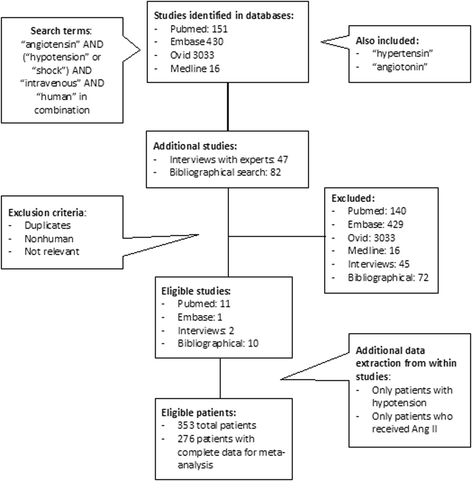The effect of angiotensin II on blood pressure in patients with circulatory shock: a structured review of the literature
- PMID: 29282149
- PMCID: PMC5745607
- DOI: 10.1186/s13054-017-1896-6
The effect of angiotensin II on blood pressure in patients with circulatory shock: a structured review of the literature
Abstract
Background: Circulatory shock is a common syndrome with a high mortality and limited therapeutic options. Despite its discovery and use in clinical and experimental settings more than a half-century ago, angiotensin II (Ang II) has only been recently evaluated as a vasopressor in distributive shock. We examined existing literature for associations between Ang II and the resolution of circulatory shock.
Methods: We searched PubMed, MEDLINE, Ovid, and Embase to identify all English literature accounts of intravenous Ang II in humans for the treatment of shock (systolic blood pressure [SBP] ≤ 90 mmHg or a mean arterial pressure [MAP] ≤ 65 mmHg), and hand-searched the references of extracted papers for further studies meeting inclusion criteria. Of 3743 articles identified, 24 studies including 353 patients met inclusion criteria. Complete data existed for 276 patients. Extracted data included study type, publication year, demographics, type of shock, dosing of Ang II or other vasoactive medications, and changes in BP, lactate, and urine output. BP effects were grouped according to type of shock, with additional analyses completed for patients with absent blood pressure. Shock was distributive (n = 225), cardiogenic (n = 38), or from other causes (n = 90). Blood pressure as absent in 18 patients.
Results: For the 276 patients with complete data, MAP rose by 23.4% from 63.3 mmHg to 78.1 mmHg in response to Ang II (dose range: 15 ng/kg/min to 60 mcg/min). SBP rose by 125.2% from 56.9 mmHg to 128.2 mmHg (dose range: 0.2 mcg/min to a 1500 mcg bolus). A total of 271 patients with complete data were determined to exhibit a BP effect which was directly associated with Ang II. Subgroups (patients with cardiogenic, septic, and other types of shock) exhibited similar increases in BP. In patients with absent BP, deemed to be cardiac arrest, return of spontaneous circulation (ROSC) was achieved, and BP increased by an average of 107.3 mmHg in 11 of 18 patients. The remaining seven patients with cardiac arrest did not respond.
Conclusions: Intravenous Ang II is associated with increased BP in patients with cardiogenic, distributive, and unclassified shock. A role may exist for Ang II in restoring circulation in cardiac arrest.
Keywords: Angiotensin II; Cardiac arrest; Cardiogenic shock; Distributive shock; Vasoconstrictor; Vasopressor.
Conflict of interest statement
Ethics approval
Not applicable.
Consent for publication
Not applicable.
Competing interests
The authors declare that they have no competing interests.
Publisher's Note
Springer Nature remains neutral with regard to jurisdictional claims in published maps and institutional affiliations.
Figures

Comment in
-
Angiotensin II for the treatment of vasodilatory shock: enough data to consider angiotensin II safe?Crit Care. 2018 Apr 16;22(1):96. doi: 10.1186/s13054-018-2006-0. Crit Care. 2018. PMID: 29661216 Free PMC article. No abstract available.
References
-
- Dunser MW, Mayr AJ, Ulmer H, Knotzer H, Sumann G, Pajk W, Friesenecker B, Hasibeder WR. Arginine vasopressin in advanced vasodilatory shock: a prospective, randomized, controlled study. Circulation. 2003;107(18):2313–9. doi: 10.1161/01.CIR.0000066692.71008.BB. - DOI - PubMed
Publication types
MeSH terms
Substances
LinkOut - more resources
Full Text Sources
Other Literature Sources
Medical
Miscellaneous

